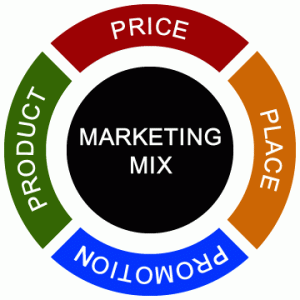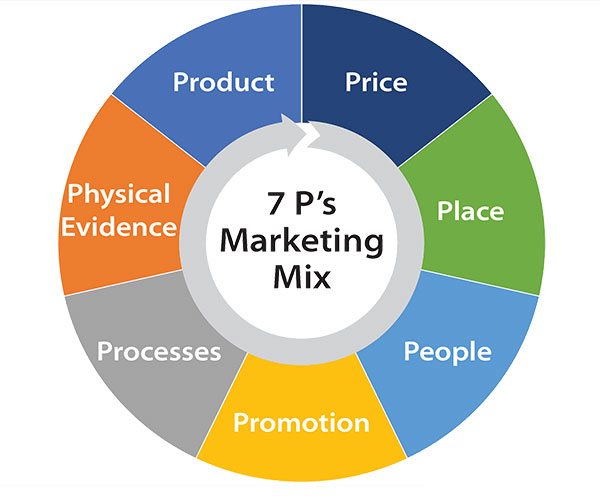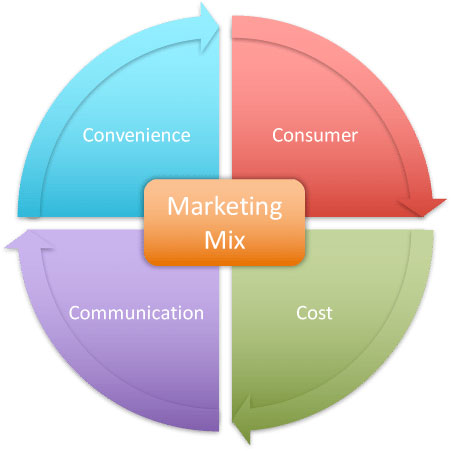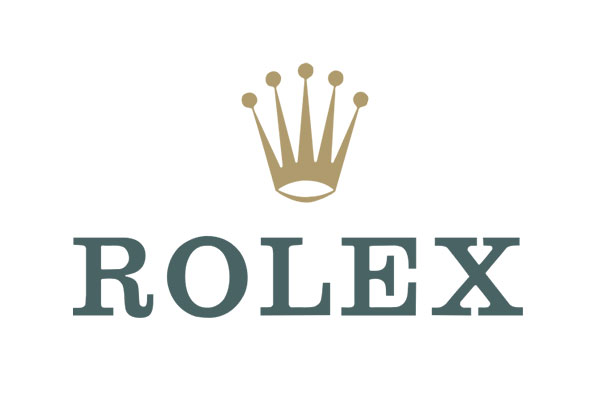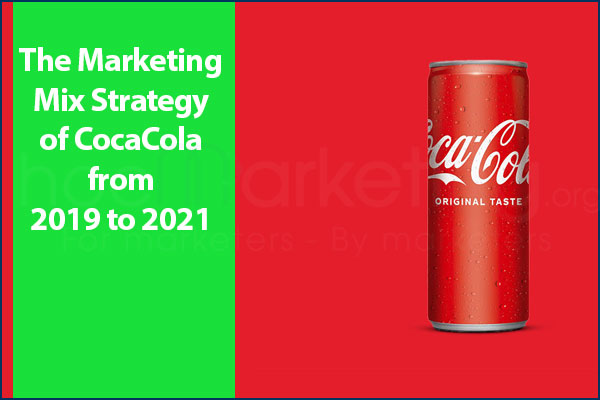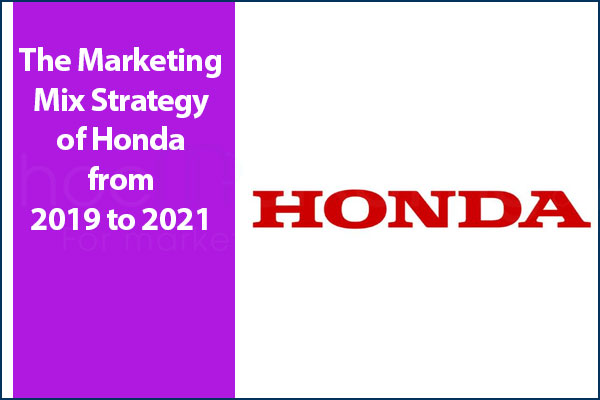
What is marketing mix? How to develop a 4Ps marketing mix strategy

What is marketing mix (Definition)? How many kinds of marketing mix (Classification)? Roles of Marketing mix in marketing. A guide on how to develop a marketing mix strategy.
What is Marketing mix?
Marketing mix is a set of marketing tools that a business blends to produce the response it wants in the target market.
Marketing mix is one of the major concepts in modern marketing. It consists of everything the business can do to engage consumers and deliver customer value.
Classification of marketing mix
There are 5 types of Marketing Mix widely used by businesses (firms) including: 4Ps, 7Ps, 4Cs, 4As and 4Os.
4Ps
4Ps is the most popular type of Marketing mix, not only in business, but also in many Marketing courses. 4Ps, of course, consists of 4 Ps as below:
P - Product: offerings that the business provides to customers in order to satisfy their needs (Marketing offerings). In other words, it means the goods-and-services combination of the company. For example, a Ford Escape (a car produced by Ford) consists of nuts and bolts, spark plugs, pistons, headlights, and thousands of other parts. Ford offers several Escape models and dozens of optional features. The car comes fully serviced and with a comprehensive warranty that is as much a part of the products as the tailpipe.
P - Price: is the amount of money customers must pay to obtain the product. For example, Ford calculates suggested retail prices that its dealers might charge for each Escape. But Ford dealers rarely charge the full sticker price. Instead, they negotiate the price with each customer, offering discounts, trade-in allowances, and credit terms. These actions adjust prices for the current competitive and economic situations and bring them into line with the buyer’s perception of the car’s value.
P - Place: includes company activities that make the product available to target consumers. Ford partners with a large body of independently owned dealerships that sell the company’s many different models. Ford selects its dealers carefully and strongly supports them. The dealers keep an inventory of Ford automobiles, demonstrate them to potential buyers, negotiate prices, close sales, and service the cars after the sale.
P - Promotion: refers to activities that communicate the merits of the product and persuade target customers to buy it. Ford spends nearly $2.5 billion each year on U.S. advertising to tell consumers about the company and its many products.11 Dealership salespeople assist potential buyers and persuade them that Ford is the best car for them. Ford and its dealers offer special promotions—sales, cash rebates, and low financing rates—as added purchase incentives. And Ford’s Facebook, Twitter, YouTube, Instagram, and other social media platforms engage consumers with the brand and with other brand fans.
2. 7Ps
7Ps is the extended version of 4Ps, when it has all 4Ps elements alongside with additional elements: People, Process and Physical evidences:
People: People who are in charge of delivering customer value. For example: Engineers, salers, consultants, shippers...
Process: The way customer value is delivered to customers. It can be the production process, sale process, consultation process, service process...
Physical Evidence: Evidence showing that products produced by the firm can be trusted by customers. For examples: Customers who have already used those products and been satisfied by their quality, customer feedback (testimonials), trial version, facilities...
3. 4Cs, 4As & 4Os
In general, 4Cs, 4As and 4Os are similar to 4Ps. In other words, 4Cs, 4As and 4Os are different just expression methods of 4Ps.
Firstly, we look at the 4Cs:
4Cs is a set of marketing tools which are similar to 4Cs. 4Cs consists of:
- Customer solutions: Which solution can a firm provide to customers in order to satisfy their needs? → Similar to Product of 4Ps
- Cost to users: How much does it cost for a customer to have the firm's solutions? → Similar to Price of 4Ps
- Convenience: Is it convenient for a customer to get access to the firm's solutions? → Similar to Place of 4Ps
- Communication: The way the firm communicate with its customers to persuade them to use the firm's solutions → Similar to Promotion of 4Ps
Secondly, we take a loot at 4As:
4A is a set of marketing tools which are similar to 4As. 4As consists of:
- Acceptability: is the extent to which the product exceeds customer expectations. Do the firm's products/services meet the customer acceptability? → Similar to Product of 4Ps
- Affordability: is the extent to which customers are willing and able to pay the product’s price. Are the firm's products/services affordable to its target customers? → Similar to Price of 4Ps
- Accessibility: is the extent to which customers can readily acquire the product. Are the firm's products/services accessible to its target customers? → Similar to Place of 4Ps
- Awareness: is the extent to which customers are informed about the product’s features, persuaded to try it, and reminded to repurchase. Are the firm's products/services assessible known by its target customers? → Similar to Promotion of 4Ps
Thirdly, let's look at 4Os:
4Os is a set of marketing tools which are similar to 4Os. 4Os consists of:
- Objects: How do your products look? How are your products produced? What kind of service that you provide to your customers... → Similar to Product of 4Ps
- Objectives: How much is your revenue (or profit) objective when you sell your products/services? → Similar to Price of 4Ps
- Organization: How do you organize your distribution channel? → Similar to Place of 4Ps
- Operation: How do you operate your promotional programs? Similar to Promotion of 4Ps
Roles of Marketing mix
Marketing mix plays a core role in Marketing activities of a business (firm) when almost all of its Marketing strategies are based on its Marketing mix.
Marketing mix helps a firm build its competitive advantages by Marketing mix tools.
Some businesses can organize their departments or teams in accordance with its marketing mix.
Developing a 4Ps marketing mix strategy
Marketing mix strategy is a part of the firm's overall marketing strategy, which indicates directions and works to do based on its Marketing mix elements, in order to develope Marketing mix elements and using those elements to deliver customer values and compete on its market.
4Ps marketing mix strategy is marketing mix strategy based on 4Ps elements: Product, Price, Place and Promotion.
Before developing a 4Ps marketing mix strategy (preparation)
Before getting started on developing the 4Ps marketing mix strategy, there is one thing you need to do or to check: Your overall marketing strategy. That means you cannot develope a marketing mix strategy without the overall one. The overall marketing strategy decides what kind of customers that the firm wants to target, what kind of values that the firm wants to provide and what position in the mind of customers that the firm wants to take place. They can be found in:
- Market segmentation: How the firm divides the total market into smaller segments.
- Market targeting: How the firm selects the segment or segments to enter.
- Market differentiation: How the firm differentiates its marketing offerings to create superior value.
- Market positioning: How the firm positions the marketing offerings in the mind of customers.
The overall marketing strategy will guide you to develop a marketing mix strategy so that it can meet the firm's marketing overall goal.
Begin developing a 4Ps marketing mix strategy
There are 5 steps envolved in developing a 4Ps Marketing mix strategy
Step 1: Design the structure of the strategy
Of course, your marketing mix strategy will not look like an article with only sentences or paragraphs. It must have a structure (format) that helps readers easily catch up with 4Ps elements.
Belows is a simple template which can help you build the format:
Source: hubspot.com
Now, we can begin filling details in each P-section.
Step 2: Product
1. A list of marketing offerings
The 4Ps marketing mix strategy should list all marketing offerings which can satisfy its target customers' needs in the Product section.
2. Quality
How much quality do the firm's marketing offerings must have? In which way does the quality defined: durability, stability, speed, capacity, component, materials, facility, staff's professionalism...?
3. Design
How do the firm's marketing offerings look like (shape, color, layout, decoration...)? How do the firm deliver services to its customers (process, location, media...)?
3. Features
Which features do the firm's marketing offerings include? For example:
"Air Max Viva" a product line produced by Nike includes these features: extra bounce, a plush collar, detailed patterning and intricate stitching.
"Iphone 12", a brand new product line, which is developed by Apple and released in October 2021, has many features. Here are top features: 5G cellular connectivity, MagSafe, OLED display, Ceramic Shield, Improved water resistance, A14 Bionic, Improved dual camera system, Front-facing camera enhancements, Smart HDR 3, Night mode enhancements, 4K HDR with Dolby Vision, 9to5Mac’s Take.
4. Brand name (Labels)
What are the firm's marketing offerings called by its target customers? How can those marketing offerings be recognized in the market?
5. Services
Services are referred to supported services when customers purchase the firm's marketing offering: consultation, delivery, installation, warranty...
Step 3: Price
1. List price
What are the prices of the firm's marketing offerings when they are launched into the market? How much profit does the firm get when selling those offerings at the supposed price? Will the prices help the firm achieve its marketing goals (market skimming, market penetration, market positioning...)?
2. Discounts
Are there any discounts offered to wholesalers, retailers and consumers? How much are those discounts?
3. Allowances
Are there any allowances offered to wholesalers and retailers? What is the form of each allowance (promotional allowance, trade-in allowance)?
4. Payment period
How many times does a customer have to pay for each of the firm's marketing offerings? How long should a customer have between each time a payment occurs during the period?
5. Credit terms
Can a customer pay the firm's marketing offerings by credit? How much interest rate charged by those credit terms?
Step 4: Place
1. Channels
What kind of distribution channels should the firm use to deliver the marketing offerings (Direct channel, 1-level channel, 2-level channel, 3-level channel, multi-level channel, modern channel)?
2. Coverage
How far can the defined distribution channels reach? Which area should the distribution channels cover?
3. Locations
Where can a customer come to buy the firm's marketing offerings? Where should the firm set up its points of sale?
4. Logistics
Where should the firm get proper materials in order to produce its marketing offerings? Where are the firm's inventories stored? Should the firm build its own warehouses or use outsourcing services? How should the firm's inventories be transported from a point of product to points of sale (by truck, train, plane, ship...)? How can the firm manage flows of materials, flows of goods and flows of information in the logistics system?
Step 5: Promotion
1. Advertising
What kind of advertising should the firm use to promote its marketing offerings? How many advertising campaigns should be launched? What kind of medias should be used for launching those advertising campaigns? How much is the advertising budget?
2. Personal selling
Should the firm build a sales force to promote its marketing offerings? How do the firm build and manage its salesforce?
3. Sales promotion
Are there any kinds of sales promotion offered to the customers (samples, coupons/vourches, refund, price packs, gifts...)?
4. Public relations
Should the firm launch any PR program to promote its marketing offerings? How much should the firm spend on those PR programs?
5. Communication
How can the firm communicate with its target customers? Will it be online, offline or both? Which media should be used as the firm's communication channel? How is the firm's Customer Relationship Management (CRM)?
By filling your marketing mix strategy form with answers to the above questions, you can have a basic 4Ps marketing mix strategy. I hope this article can help you do well in your marketing jobs or exams.
Frequently Asked Questions (FAQ)
Marketing mix is a set of marketing tools that a business blends to produce the response it wants in the target market.
Marketing mix is one of the major concepts in modern marketing. It consists of everything the business can do to engage consumers and deliver customer value
